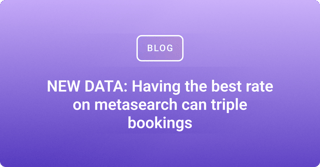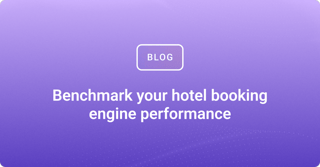But with the rise of metasearch giants like Google Hotel Ads, customer booking journeys have changed and so too have the ways hotels need to keep track of rates. Parity is now bigger than just your booking engine, which begs the question - are you monitoring the right price sources? As we enter the post-Covid travel rebound, you’ll need to broaden the scope of your parity monitoring to look beyond your booking engine and select partner OTAs if you want to keep track of where customers are seeing your direct price.
Global travel is bouncing back but potential customers aren’t necessarily heading directly to your booking engine. Seventy three percent of guests now use metasearch sites regularly in their pre-booking journey, with Google Hotel Ads dominating the scene. Hotels finally have the chance to compete, yet OTAs are spending billions to squeeze you out - driving ten times more booking revenue from metasearch than hotels.
Hoteliers can no longer simply rely on the old way of monitoring parity - you need to be keeping track of rates on metasearch too. But how can you keep up with the rapid pace of metasearch given the sheer variety of OTA players and constant fluctuation of rates?
Step aside booking engine, prepare yourself for the new parity
Triptease has long supported hotels with monitoring their parity for the real guest searches happening on their booking engine. This is important to to keep track of undercutting rates and ensure that the OTAs you choose to partner with are playing by the rules you set. But it’s important to understand that monitoring parity in this way does not provide a real indication of how customers are actually seeing your direct price on metasearch.
To ensure you’re able to see the full picture when it comes to your online prices, you need to step away from your booking engine. This doesn’t mean neglecting the old way of monitoring parity - this still has immense value. It simply means understanding how customer experiences on meta are different.
The most important lesson here is that you’re up against a far greater range of players. This is not just your specific OTA partners. On metasearch your direct price will be competing against wholesalers and ‘random.com’ OTAs you may never have heard of. You need to be monitoring their rates too. Remember that on metasearch there is nowhere for an out-of-parity rate to hide. If your rate is being undercut then you are immediately at risk of losing the direct booking.
You also need to be monitoring price undercuts in a way that is relevant to how customers actually see your direct price on this channel. Metasearch is a rate parity battleground - having the best rate can be the difference between winning or losing the customer’s booking. So whereas traditional parity monitoring meant paying attention to when your direct rate is cheaper, in parity and undercut for each real guest search made on your booking engine, the new way of monitoring parity requires hoteliers pay more attention to when they’re being undercut. This is because from the customer’s perspective you are considered undercut even if just one OTA price is cheaper.
But how exactly should you be keeping track of when you’re being undercut on metasearch? If keeping your eyes glued to your booking engine is no longer the answer, then where should you be looking?
Introducing: Metasearch Parity Insights
You could simply start searching for your hotel on Google and see how your direct price compares to OTAs in the metasearch results. This would show you some of the players you’re up against. But this is an imperfect solution. Why? Because what you’re seeing is not necessarily the same as what everyone else is seeing.
On metasearch prices are fluctuating all the time. So even if you appear to be in parity now, thousands of guests may have seen your direct price undercut yesterday. OTAs can also use different prices in metasearch for guests in different locations or using different device types. There is no guarantee that the OTA price showing on metasearch is the same price you’d see if you visited the OTA website directly, because what is shown on meta is completely dependent on the person searching. All of this creates a conundrum for the hotelier struggling to keep up.
It is precisely for this reason that Triptease has launched a brand new dashboard - Metasearch Parity Insights. Available to hotels using both Triptease Meta and Parity, the dashboard is designed to give you insight into how customers are seeing your direct price on metasearch. It won’t show you individual disparities for each search made on meta - processing that amount of data would be an impossible task. Instead you’ll see a simple overview of the trends happening on metasearch over time, as shown below:

The goal is to provide hoteliers with insight into how guests are actually seeing their direct price on meta and how parity has impacted their performance on this channel in terms of click-through rates and revenue potential.
How to take action based on what you see in Metasearch Parity Insights
Say you’ve noticed a problem with your parity on metasearch. Here’s some of the things the dashboard may help you to do:
- Tackle your rate parity for your most impacted properties based on your ‘parity health score’.
- Confront your worst offending OTAs. On the dashboard you can clearly see who your worst offending OTAs are on meta. This will enable you to take action against those specific OTAs that are causing problems, whether by managing distribution partners or reducing the number of wholesalers you work with.
- Add new OTAs that are undercutting you constantly on metasearch to your parity monitoring on the Triptease Parity Manager - Triptease allows you to track some of the biggest undercutters on metasearch, including Snaptravel and Traveleuro.
- Talk to your revenue manager and show them the impact that reducing undercuts with OTAs could have on your direct bookings on meta. The dashboard calculates your ‘estimated lost revenue’ for each of your properties based on the parity health score.
- If your meta parity is poor, then consider using onsite conversion tools to disrupt the typical booking journey of a guest who has seen a lower price on meta. Triptease’s Meta Price Undercut targeting feature allows hoteliers to personalize the onsite experience for customers who’ve seen a lower price elsewhere on meta, providing a discount code for use on the hotel’s direct website, as shown below:

Making informed, data-backed decisions to boost your performance on metasearch could be the difference between losing to undercutting OTAs and winning direct bookings as global travel continues to grow.
Continue to leverage parity in your metasearch bids
Monitoring and fixing your parity on metasearch is only one piece of the puzzle. The other important piece is your bidding strategy.
It’s impossible to manually adjust every single bid on every metasearch platform based on your parity status. This is why - if you’re serious about maximizing your metasearch performance and spending your budget wisely - you need an automated solution that can do this for you.
By automating the process, hoteliers have been able to keep up with shapeshifting OTAs that update their bids constantly. Triptease’s market-leading algorithms are continuously checking your parity and adjusting bids based on whether you are cheaper direct, in parity or undercut. Using automated parity bidding can boost your meta performance in three ways:
- Triptease’s Parity Boost bids up when you’re in parity or cheaper direct to make sure you win the direct booking.
- Triptease bids down when you’re slightly undercut to save costs but ensure you remain visible for searchers who may still consider booking direct.
- Triptease’s flagship Parity Blackout ensures your hotel is removed from the meta auction when you’re significantly undercut to save costs and protect your brand.
Finally, don’t forget that reinforcing your price parity across the offsite and onsite booking experience can increase your metasearch performance by 118%! Even if you have strong parity on metasearch, continue to invest in onsite conversion tools like Triptease’s Targeted Messages to ensure that your guests convert.
Similarly if you’re undercut on meta, onsite conversion tools can still help capture direct bookings. Even when you don’t have the best price, customers are still likely to click through to your website for research purposes before booking elsewhere. This is your chance to grab their attention and convince them that booking direct is best - so make sure you’re not losing out! Building a consistent, personalized customer journey both onsite and offsite is key to winning bookings back from OTAs on metasearch.
Want to learn more about how a combination of Triptease Meta, Parity and Convert tools like Targeted Messages can increase your hotel’s conversion rates? Fill in the form below and one of our direct booking experts will get back to you!
Benjamin is a Product Marketing Executive for Triptease Metasearch. He's passionate about helping hotels leverage technology to maximize their direct booking potential.








